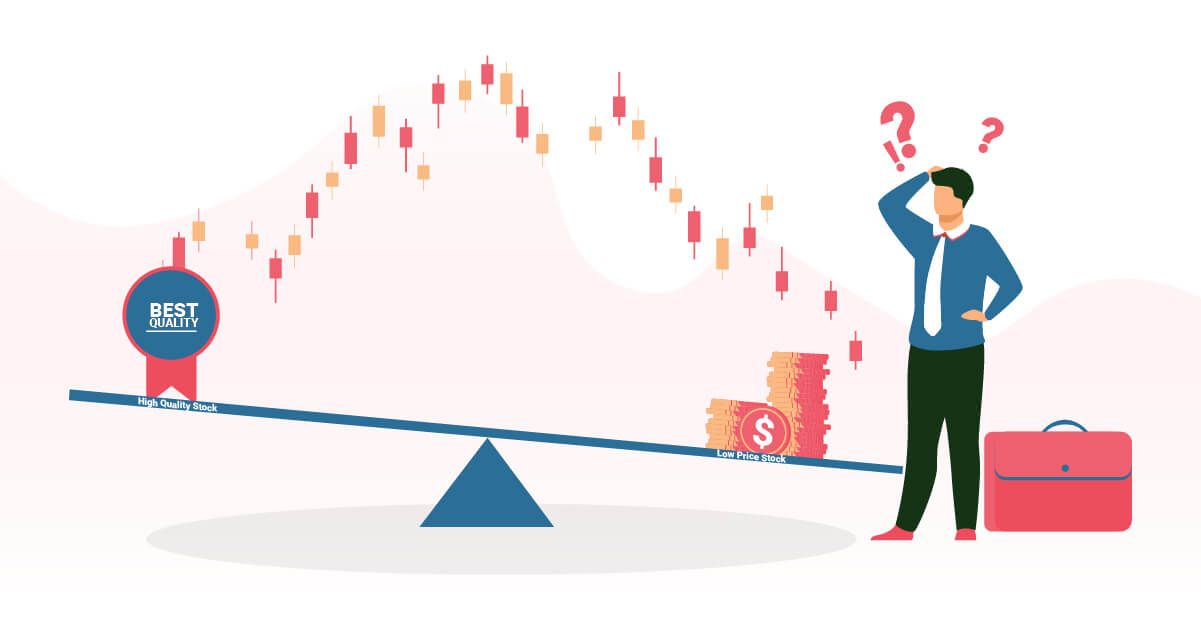High Quality Stock vs Low Price Stock

- Published Date: January 03, 2021
- Updated Date: November 28, 2025
- By Team Choice
Investments in stock markets can get extremely tricky. There are a few stocks which will be available at an extremely cheap rate and there will be some which will be extremely expensive. But how do we decide expensive and cheap? Is it just the price that we look at or are there any other aspects we need to look at? Moreover, what should you go with if you were to decide between a low-price stock and a high-quality stock?
In today’s blog, we will address all these questions with the aim of helping you in making the decision.
So, let’s start with Low Price Stock
Most of the investors associate low price to a really good bargain as they will be able to buy more shares for the same amount compared to other stocks which have very high price. But this approach may not always be right. Let’s look at some examples:
Yes Bank – Over the last 2 years, Yes Bank’s stock has come down from 339 to 28. And during this time the retail shareholding went up from 12.58% to 62.29% as of December 2019.
DHFL – This the case is also similar to Yes Bank. The DHFL stock price moved from 605 to 13 over the last 2 years and the retail shareholding went up from 31.33% to 54.18% as of March 2020.
This simply proves the point we are trying to make. There is a phrase that is used very frequently when it comes to stocks like these “Falling Knives”. No matter how much the price is, Falling Knives will always hurt the portfolio. They do not have any potential to generate returns because of major fundamental issues. The Yes Bank and DHFL both had severe corporate governance issues that were out in the open for a very long time. Even after this information, retail investors increased their stake on one single aspect: the price of the stock.
Open a FREE Demat Account in 5 Mins.
- Free AMC for First Year
- Low DP Charges (₹ 10)
- No Auto Square Off Charges
- Free Research Calls
You cannot look at the price of the stock on a standalone basis. You need to compare it with multiple other factors like:
- Is the company reporting an increase in Profit on YOY Basis?
- Is the company’s debt decreasing over the last few years?
- What is the ROE and ROCE of the company over short and long terms
- Have promoters pledged any portion of the shares of the company?
- How is the company’s credit rating?
If a company is fundamentally good and still trading at a lower price then it’s a great buy. But if there is even one red flag in the company’s financial statement or company’s management then it may create a problem in the future.
Hence, do not just go with the share price. Look at other fundamental aspects and then make a decision.
So, What about high-quality stock? Quality at any price, right?
The answer to this is No. Quality at any price never works in favor of the investor. While investing in high-quality stock is always a good idea, but if it is overpriced then it eventually has to come back to its fair price. Here are some quality names which saw a huge drawdown in recent market fall:
Bajaj Finance – Bajaj Finance stock price came down from its an all-time high of 4880 to 2390 in a matter of 2.5 months. This fall is about 51% in absolute terms. Now to recover from this price and reach to its original high, Bajaj Finance needs to give a return of almost 100%.
Axis Bank – Axis stock price corrected from 735 to 405 in 2.5 months. Similar to Bajaj Finance, this is also a fall of about 45% which now needs to give a return of 80% to recover and reach its previous high.
One of the factors you can use to identify whether a stock price is justified is Price to Earnings Ratio. It basically shows how the price is moving with respect to earnings. If the PE ratio is continuously going up then it means that stock is getting overpriced. But if it is continuously going down then it means that stock is underpriced.
This is just one of the factors, with this, the assessment of the fundamental quality is of course extremely important.
While buying a high-quality stock, Quality at a reasonable price should your motto. This way no matter what the company is, you will buy it only if it justifies the valuation at which it is currently trading.
We hope this helps you in making the right decisions for your portfolio. For more assistance, feel free to get in touch with our support team.
Recommended for you

Copper Price Forecast for Next Week

Indian Stock Market Prediction For Next Week

FII DII Data - Live Data
